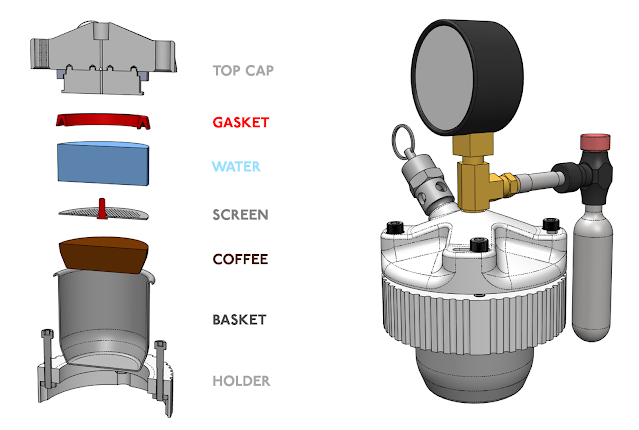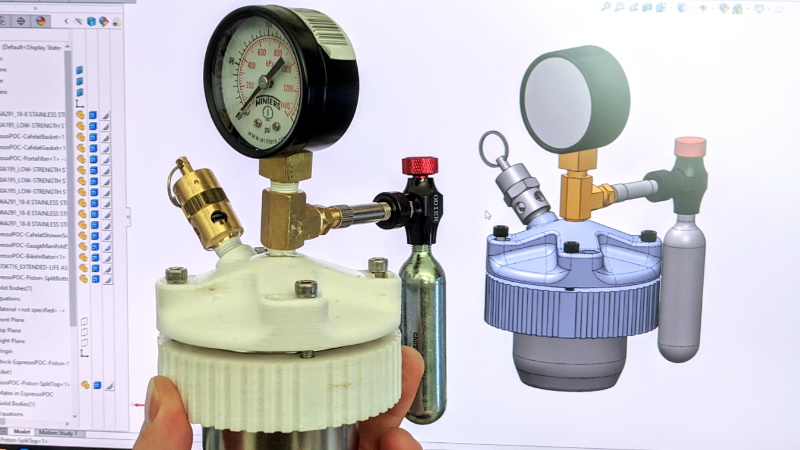Virtually any hobby has an endless series of rabbit holes to fall into, with new details to learn around every corner. This is true for beekeeping, microcontrollers, bicycles, and gardening (just to name a few), but those involved in the intricate world of coffee roasting and brewing turn this detail dial up to the max. There are countless methods of making coffee, all with devout followers and detractors alike, and each with its unique set of equipment. To explore one of those methods and brew a perfect espresso, [Eric] turned to his trusted 3D printer and some compressed gas cylinders.
 An espresso machine uses high pressure to force hot water through finely ground coffee. This pressure is often developed with an electric pump, but there are manual espresso machines as well. These require expensive parts which can withstand high forces, so rather than build a heavy-duty machine with levers, [Eric] turned to compressed CO2 to deliver the high pressure needed.
An espresso machine uses high pressure to force hot water through finely ground coffee. This pressure is often developed with an electric pump, but there are manual espresso machines as well. These require expensive parts which can withstand high forces, so rather than build a heavy-duty machine with levers, [Eric] turned to compressed CO2 to deliver the high pressure needed.
To build the pressure/brew chamber, he 3D printed most of the parts with the exception of the metal basked which holds the coffee. The 3D printed cap needs to withstand around nine atmospheres of pressure so it’s reasonably thick, held down with four large bolts, and holds a small CO2 canister, relief valve, and pressure gauge.
To [Eric]’s fine tastes, the contraption makes an excellent cup of coffee at minimal cost compared to a traditional espresso machine. The expendable CO2 cartridges only add $0.15 to the total cost of the cup and for it’s simplicity and small size this is an excellent trade-off. He plans to improve on the design over time, and we can’t wait to see what he discovers. In the meantime, we’ll focus on making sure that our beans are of the highest quality so they’re ready for that next espresso.
Thanks to [squashed_buckler] for the tip!















One could make it more environementally friendly by using an electric compressor ^^
While it is cool I am a bit worried about combining plastic, boiling water and high pressure, I do need a kick to wake my up in the morning but scalding ain’t it. Guess I’ll just stick with my turkish coffee for now, you only need a pot and a toothbrush for that, but if he ever makes one of these in stainless steel I’m in.
>combining plastic, boiling water and high pressure
A big BANG in the morning is probably more effective than any coffee to get awake…
scnr
True, but then they could have just used a 555 (to set off a firecracker) and avoided the risk of getting a face full of scalding water with the big bang.
Very neat. Wouldn’t the CO2 add acidity though?
And it would rapidly cool the water due to decompression
How about using whippets? You know NO2 cylinders used to make whipped cream.
Brass that contains lead as well as not food grade 3D printed plastic.
Brass is OK, it is a copper and zinc alloy, and extensively used by the food industry. You are thinking about bronze. Unknown plastics, on the other hand… (I sell spare parts for espresso machines, among other things, I know what I’m talking about)
Some brass alloys have lead to increase machinability.
Please consider updating your knowledge base about lead content in brass.
https://en.wikipedia.org/wiki/Brass#Lead_content
I had no idea that lead free brass water footings could contain 4% lead before 2010. PEX water piping in houses makes a lot more sense to me now.
And this do not prevent it being approved for food use, that was my point.
Given the solubility of CO2 in hot water is negligible, probably not.
Humans, in addition to their computing capabilities, also possess the ability to create significant leverage forces on an expresso hand pump, obviating the drawback of the waste created by spent CO2 canisters. Does the planet really care how much they cost? Humans are vastly overlooked when it comes to their versatility.
The canisters are *extremely* recyclable.
There is something better than recycle. Not use it in the first place.
Why do anything ever, then? Just sit naked in a ditch and wait to die?
So using a hand pumped expresso machine is similar to sitting naked in a ditch? How did you get there?
Simple. If you’re going to throw away other people’s design constraints arbitrarily, you may as well throw them all away, including ALL the unstated ones. Since that ends up somewhere utterly ridiculous, you have to stop at some point before that, and the most sensible place to do that is the same place the project author did.
I love this!. Inspiring. I have been wanting to make something like this from random plumbing fittings.
manual pump ? – https://silodrome.com/rok-manual-espresso-maker/
I have been using Wacaco Minipresso GR since one year ago, replacing most of the time my Nespresso Inisia, beside that I can use the wacaco with ground coffee instead of pods. I can say that this device is pretty decent. Also, because it is small, it comes with me all the time.
https://www.wacaco.com/pages/minipresso-gr
The CO2 is in direct contact with the water.
Does this make sparkling espresso?
There’s a reason why all carbonated beverages are cold, CO2 doesn’t dissolve in hot water.
The missing link is… well, you guess it. Those things actually being recycled.
Raw materials are (as of today) obscenely cheap to actually motivate this. So either we make them significantly more expensive, or we change some basics in our economy (The Horrors!) or we fail as humankind.
Kind of an engineering decision.
Nothing gets recycled, relatively speaking. If we didn’t recycle anything at all the landfills would only be a little bigger. Recycling doesn’t even make a dent in the problem.